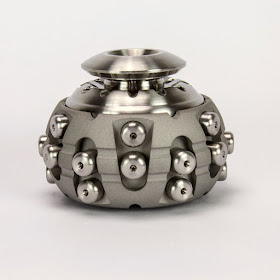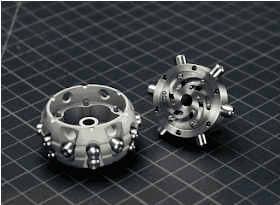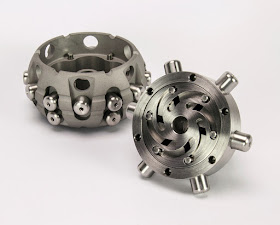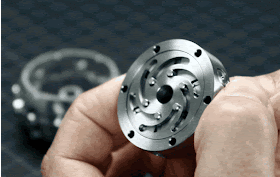Project Preface:
Since I began exploring modern machine work as an artistic medium over 15 years ago, my focus has been predominantly on creating a kind of machined fine art sculpture. Over time however, the connections I’ve made between my work and various spheres of design, engineering, and even the decorative arts have slowly expanded my conception of what my sculpture practice could be. In the past, I would never have undertaken some of the mechanical design projects I am now pursuing, likely out of fear they might distract, rather than compliment, my creative output. This fear I have come to realize was largely misplaced.
Since I began exploring modern machine work as an artistic medium over 15 years ago, my focus has been predominantly on creating a kind of machined fine art sculpture. Over time however, the connections I’ve made between my work and various spheres of design, engineering, and even the decorative arts have slowly expanded my conception of what my sculpture practice could be. In the past, I would never have undertaken some of the mechanical design projects I am now pursuing, likely out of fear they might distract, rather than compliment, my creative output. This fear I have come to realize was largely misplaced.
As I have sought to articulate my intention with my work on this blog, a recurring theme has emerged. From my position as a creator, (as apposed to a viewer) distinguishing between what is fine art, what is design, and what is craft, has become highly problematic.
From a process perspective, the act of making art is largely indistinguishable from making anything else. There is as much value (from a domain knowledge standpoint) in making something like a tool, as there is the most inspired work of sculpture (emphasis here on the making and not the viewing). I’ve also come to understand that domain knowledge is the well from which most creativity springs. It is the work that leads to inspiration, and not (as is popularly thought) inspiration that leads to the making of work. So whether you call it design, craft, or art makes no difference to the artist. The result of any single project may or may not invoke a sense of awe in others, but regardless, it is quite likely a step toward something that will.
With that said, today’s post is a new design collaboration that directly addresses this evolving outlook on my craft. It is my second project with Mike and Callye from Revolvemakers. This vessel-like work is an expedition into what most would characterize as the decorative arts. A bit of a departure for everyone involved, this work is an amalgam of disparate ideas I have encountered over the years that perfectly encapsulate the many intersections between art and design as they are popularly understood.
The following is an attempt to describe all of the various inspirations and how they connect.
Inspiration For The Netsuke Hybrid Vessel Bead:
The earliest seed for this work came in 2008 when I was asked to make a small funeral Urn for a friend of mine who had lost her mother. I obliged this friend (of course) and made a small-machined metal vessel (as seen above). When I was finished, I was pleased to find that it had many of the qualities I was looking for in my regular sculpture work. Sadly, my preoccupation with only making sculpture at that time stopped me from pursuing the concept further.
What has finally brought me back to the vessel idea, and the rest of the inspiration for this piece, was my search for other contemporaries who are exploring the aesthetic side of machine work. Instead of finding other sculptors, I found a number of professional machinists who are branching out from their traditional roles to explore the more creative possibilities within their trade.
These machinist craftsmen are primarily creating functional objects and do not necessarily consider what they are doing to be art. Their aim however, is not so different than mine, they wish to express themselves and maybe make something beautiful in the process. Rather than sculpture, they are making lanyard beads, folding knives, spin tops, fidget toys, pens, flashlights, and other tactical type accoutrements. Many of them are progressing into the type of embellishment and thoughtfulness of craft that has seen many industrial crafts blossom into a fine arts movement. Crafts like wood turning, glass blowing, welding, and ceramics have all transitioned from commercial industries to fine and decorative art traditions.
My interest in how industrial processes morph into arts movements is what first set me on a path of exploring a kind of functional art of my own. Looking for similarities between the decorative arts and machining is where the rest of the inspiration for this work was found.
In doing my research for these functional projects, I began looking for older forms of utilitarian art. My earlier adventures in small sculpture had brought Japanese Netsuke to my attention (see below). Further digging revealed that Sagemono as it relates to Netsuke, as well as Chinese snuff bottles had qualities that I could relate to this project. These object forms with their long and storied histories seemed like they would be perfectly at home in the contemporary environment of machined decorative arts.
What is Netsuke and Sagemono?
For those who are unfamiliar with Netsuke and Sagemono, I whole-heartedly suggest you take a look into this amazing tradition, but for simplicity sake, I have copied a simple description from the International Netsuke Society page.
In Short: A netsuke is a small sculptural object, which has gradually developed in Japan over a period of more than three hundred years. Netsuke (singular and plural) initially served both functional and aesthetic purposes. The traditional form of Japanese dress, the kimono, had no pockets. Women would tuck small personal items into their sleeves, but men suspended their tobacco pouches, pipes, purses, writing implements, and other items of daily use on a silk cord passed behind their obi (sash). These hanging objects are called sagemono. The netsuke was attached to the other end of the cord preventing the cord from slipping through the obi. A sliding bead (ojime) was strung on the cord between the netsuke and the sagemono to allow the opening and closing of the sagemono.
The entire ensemble was then worn, at the waist, and functioned as a sort of removable external pocket. All three objects (netsuke, ojime and the different types of sagemono) were often beautifully decorated with elaborate carving, lacquer work, or inlays of rare and exotic materials.
What are Chinese Snuff Bottles?
Chinese snuff bottles, well? were used to hold snuff of course. But they were also highly adorned objects that represent a decorative art form displaying a wide range of experimentation with materials within a narrow range of designs. This art form echoes trends within the machining community where a single design is often iterated in a variety of metals and exotic alloys to achieve distinct looks and qualities. A link is here for further exploration.
My Take on it all:
Together, the Netsuke, Sagemono, and Chinese snuff bottles seemed analogous to some of the finely machined and decorated lanyard beads and other tactical pieces I was seeing in the machinist community. I sensed the potential for collaboration with the past. Both my recent past, which involves my urn project, and the distant past with these venerable decorative art forms.
While the look of these traditional forms may be quite different from the machined objects to which I am referring, I am more interested in the shared impulse they both represent. The impulse to decorate and improve ones most cherished utilitarian possessions, and how this act often grows to the point where the art begins to take priority over the original function of the object. Anyone who follows how gloriously large, complex, and impractical modern luxury watches have become can attest to how this can play out.
This transformation from functional craft to creative art form can happen over years, decades, or centuries, but the process is usually the same. The focus of the work becomes less and less about the usefulness of the thing, and more and more about the craft itself. The object becomes secondary to the act of making; eventually the original object can be completely abandoned in favor of new technical or conceptual challenges within the craft. What remains is a medium ripe for art for art’s sake.
Conclusion:
So to bring this all back together and how it led to this design. After my experience making my small urn, I have often thought of returning to making a vessel form of some kind. The thing preventing me from doing so was my inability to conceptually connect it to the rest of my work. But as I have pursued more functional art projects to explore a broader design and craft context for my work, I realized that I could link all of these disparate influences into one project.
The “Netsuke Hybrid Vessel Bead” is the result. It is something that I hope speaks to how universal the impulse to make something both useful and beautiful can be. How an items function can influence design across time.
Build Notes:
Callye, Mike and I have been bouncing ideas and parts for this prototype back and fourth for months. The piece has slowly taken shape since January as the team worked out the bugs in the mechanics and made small adjustments to the design. We still have a little fine-tuning to go before we start producing an edition of these, but we could not wait any longer to share the project with all of you.
Dimensions are a bit over 2" Diameter by 1.5" Tall.
So what is it for? What does it do? Some people may feel like this is a project that tries to do too much, tries to do too many things and so does not do any of them well. I say that is sort of the point. As functional art goes in my mind, the creative content is always the foremost consideration over practicality.
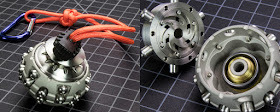 |
| (left) sagemono arrangement, (forgive my rookie knots).........(right) test with ring adapter (still needs work) |
So, it is many things, it is a container (but a rather small one), but it is also a lanyard style bead (a rather large and impractical one) with a through bore to receive a piece of paracord. It could be worn sagemono style when paired with a second lanyard bead (obi analogue) and a carabiner (netsuke analog), something other machinist in the community could easily contribute to this project on. Those of you who machine or collect rings, you can use it as a ring box (something we have tested). Or use it as a snuffbox (something we have not tested), what ever you like. I am sure many of you will come up with interesting uses.
That the work has such flexibility in what it can be used for opens the door to additional collaboration with makers in the future. I am looking forward to seeing how it is interpreted by others in the machinist community.
Other thoughts:
One of the final noteworthy considerations in designing this was wether we should leave the mechanics of the iris visible to the user. There is no doubt that it looks incredible, however leaving the mechanics exposed opens the door to getting particulate matter into the iris, which could lead to a jam. For now we have decided the benefit of leaving the mechanics visible outweigh the risks, so a bit of care may need to be taken when considering what to use it for. This is a limiting factor of the design, but my aim all along was to put the aesthetics of the piece ahead of other considerations.
How can I get one?
We are planning on doing a preorder later this week for those of you interested in collecting one of these works. The initial run will likely be around 50 pieces total (that is our working number, we may adjust this some). Whether there will be a second batch or other variants in the future is unknown at this time.
Because demand has been so high for my small projects (the last edition sold out in under an hour), we will be following a similar protocol to previous releases.
The pre-sale will go as follows.
I will post a link to a sign up form on Friday July 28th at 11:00 AM (Eastern Standard Time). I will send the link for this form via email newsletter first, I will then post it here on this blog, last I will post it to my Instagram account.
I know time zones and distance play a factor in how quickly the link shows up, but for those of you who want to attempt to sign up first, I have done my best to give you accurate info to give you the best shot.
The pre-order will stay open for exactly one week.
I know time zones and distance play a factor in how quickly the link shows up, but for those of you who want to attempt to sign up first, I have done my best to give you accurate info to give you the best shot.
The pre-order will stay open for exactly one week.
Everyone will be limited to just one piece, and one sign up per person.
First 25 names on the list will get to reserve one of the works outright. The other 25 or so spots will be distributed raffle style to the remaining names on the list.
As is my policy, I do not post pricing on publicly facing media. Pricing info will be included on the sign up form. Obviously this is a very complex project, those of you familiar with the price of previous editions might be able to arrive at a reasonable guess. But simply check the form on Friday if you are curious and decide from there if it is within your means to collect.
If you are Late to this project, I am sorry to say the moment has passed.

